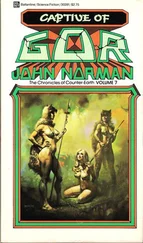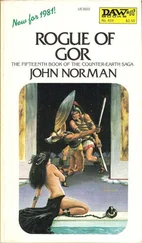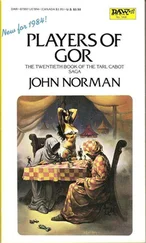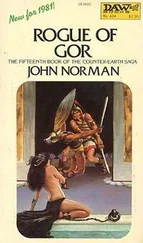They now stood bound before the praetor.
“Turgus, of Port Kar,” said the praetor, “in virtue of what we have here today established, and in virtue of the general warrant outstanding upon you, you are sentenced to banishment. If you are found within the limits of the city after sunset this day you will be impaled.”
The face of Turgus was impassive.
“Free him,” he said.
Turgus was cut free, and turned about, moving through the crowd. He thrust men aside.
Suddenly he saw me. His face turned white, and he spun about, and fled.
I saw one of the black seamen, the one who had passed me on the north walkway of the Rim canal, when I had been descending toward the pier, looking at me, curiously.
The girl looked up at the praetor. The neck strap, now that Turgus was freed of it, looped gracefully up to her throat, held in the hand of a guardsman. Her small wrists were still bound behind her back.
She seemed very small and helpless before the high desk.
“Please let me go,” she said. “I will be good.”
“The Lady Sasi, of Port Kar,” said the praetor, “in virtue of what we have here today established, and in virtue of the general warrant outstanding upon her, must come under sentence.”
“Please, my officer,” she begged.
“I am now going to sentence you,” he said.
“Please,” she cried, “Sentence me only to a penal brothel!”
“The penal brothel is too good for you,” said the praetor.
“Show me mercy,” she begged.
“You will be shown no mercy,” he said.
She looked up at him, with horror.
“You are sentenced to slavery,” he said.
“No, no!” she screamed.
One of the guards cuffed her across the mouth, snapping her head back.
There were tears in her eyes and blood at her lip.
“Were you given permission to speak?” asked the praetor.
“No, no,” she wept, stammering. “Forgive me—Master.”
“Let her be taken to the nearest metal shop and branded,” said the praetor. “Then let her be placed on sale outside the shop for five Ehn, to be sold to the first buyer for the cost of her branding. If she is not sold in five Ehn then take her to the public market shelves and chain her there, taking the best offer which equals or exceeds the cost of her branding.”
The girl looked up at the praetor. The strap, in the hand of the guardsman, grew taut at her throat.
“This tarsk bit,” said the praetor, lifting the coin which had been taken from her mouth earlier, “is now confiscated, and becomes the property of the port.” This was appropriate. Slaves own nothing. It is, rather, they who are owned.
The girl, the new slave, was then dragged stumbling away from the tribunal.
I noted that Ulafi, captain of the Palms of Schendi, and his first officer, were now standing near me in the crowd. They were looking at me.
I made my way toward them.
“I would book passage on the Palms of Schendi,” I told them.
“You are not a metal worker,” said Ulafi to me, quietly.
I shrugged. “I would book passage,” I said.
“We do not carry passengers,” he said. Then he, and his first officer, turned away. I watched them go.
The praetor was now conversing with the fellow, Bem Shandar, from Tabor. Papers were being filled in; these had to do with the claims Bem Shandar was making to recover his stolen money.
“Captain!” I called to Ulafi.
He turned. The crowd was dispersing.
“I could pay a silver tarsk for passage,” I told him.
“You seem desperate to leave Port Kar,” said he.
“Perhaps,” I told him.
“We do not carry passengers,” said he. He turned away. His first officer followed him.
I went to a guardsman, near the praetor station. “What efforts are being mace to recover the lost slave?” I asked.
“Are you with the Palms of Schendi?” he asked.
“I hope to book passage on that ship,” I said. “I fear the captain will delay his departure until she is recovered.” I was sure this was the case.
“We are conducting a search,” said the guardsman.
“She may be wearing the garment of a she-urt,” I said.
“That is known to us, Citizen,” said he.
“I myself,” said a nearby guardsman, “stopped a girl answering the description, one in the torn rag of a she-urt, but when I forced her to reveal her thighs, she was unmarked.”
“Where did you find such a girl?” I asked.
“Near the Spice Pier;” he said.
“My thanks, Guardsman,” said I.
It seemed to me that the blond girl might well consider various strategies for eluding capture. I did not think she would be likely to flee east along the canal walkways, for these were relatively narrow and, on them, between the buildings and the canal, she might be easily trapped. Also, though this would not figure in her thinking, she could, on the north, east and south, be trapped against the delta walls or at the marsh gates. I did not think it likely she would risk stealing a boat. Even if she could handle a small craft, which I doubted, for she was an Earth girl, probably from an urban area, the risk of discovery would be too great. Also, though she did not know it, a she-urt in a boat would surely provoke instant suspicion. Where would such a girl obtain a boat, if she had not stolen it. Too, it would, given the construction of the buildings of Port Kar, be difficult to attain the roof of one from the outside of the building. I did not think she would try to gain admittance to a building. She would probably then, in my opinion, try to find her way to markets or stay about the wharves. The markets were, for the most part, save the wharf markets, deeper in the city. I did not think she would reach them, or know how to find them. She was then, probably, in the vicinity of the wharves. Here she would, presumably, attempt to conceal herself. She might hide in various ways. Obvious ways of hiding would be to conceal herself among the boxes and bales at the wharves, to creep into a crate, or barrel, or to cover herself with sheets of sail canvas or with heavy coils of mooring rope. Guardsmen, I was certain, would examine such possibilities systematically. Too, a she-urt found in such a place, it not being night, would surely be viewed as a girl in hiding. She would presumably then be tied and taken to the praetor. Perhaps she is wanted for something.
I was now in the vicinity of the Spice Pier.
I did not think my quarry would elect an obvious way of hiding, one in which she, if found, would be immediately exposed as a fugitive. She was doubtless highly intelligent. She had been chosen as a Kur agent.
I seized a dark-haired she-urt by the arm. “Let me go,” she screamed. “I have done nothing!”
“Where do the she-urts band?” I asked.
“Let me go!” she cried.
I shook her. “Oh, oh,” she cried.
I then stopped shaking her. I held her by the arms, her toes barely touching the ground. She was then quiet, looking up at me. Her eyes were frightened. I saw she was ready to be obedient.
“There are some girls behind the paga taverns, on the northern shore of the Ribbon’s alley,” she said.
I released her and she sank to her knees, gasping.
The Ribbon is one of Port Kar’s better-known canals. A narrower canal, somewhat south of it is called the Ribbon’s alley. It was a bit past dawn and the paga taverns backing on the smaller canal would be throwing out their garbage from the preceding night. She-urts sometimes gather at such places for their pick of the remnants of feasts.
It would be less than an Ahn until the fullness of the tide. I quickly crossed two bridges, leading over canals, each joining the sea. Then I walked eastward, and took a left and a right, and crossed another small bridge. I was then on the northern shore of the Ribbon’s alley. The Ribbon’s alley, like most small canals, and many of the larger canals, does not join the sea directly but only by means of linkages with other canals. The larger canals in Port Kar, incidentally, have few bridges, and those they have are commonly swing bridges, which may be floated back against the canal’s side. This makes it possible for merchant ships, round ships, with permanently fixed masts, to move within the city, and, from the military point of view, makes it possible to block canals and also, when drawn back, isolate given areas of the city by the canals which function then as moats. The swing bridges are normally fastened back, except from the eighth to the tenth Ahn and from the fifteenth to the seventeenth Ahn. Most families in Port Kar own their own boats. These boats are generally shallow-drafted, narrow and single-oared, the one oar being used to both propel and guide the boat. Even children use these boats. There are, of course, a variety of types of craft in the canals, ranging from ramships harbored in the courts of captains to the coracles of the poor, like leather tubs, propelled by the thrusting of a pole. Along the sides of the major canals there are commonly hundreds of boats moored. These are usually covered at night.
Читать дальше












